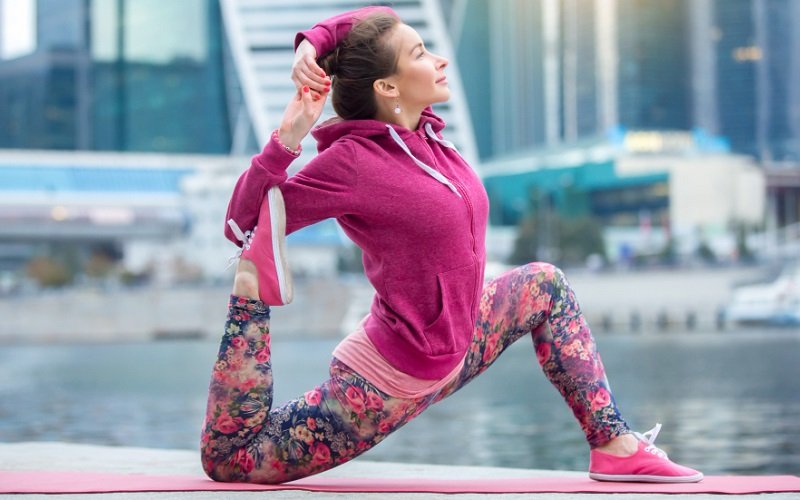Find out how good morning exercise can help your back. Find out how this useful exercise can make your lower back stronger, help your balance, and lower your risk of getting hurt.
“Good morning” could be the subject line of an email, a cute text message your boyfriend sends you while he’s away on business, or just the best way to start any morning that doesn’t start with an alarm.
But saying “good morning” is also a workout that you should do.
Have you never heard of it? This guide is for you. It will show you how to do the good morning exercise correctly and explain why you should add it to your routine.
How to Do the Good Morning Exercise
An easy form of the good morning workout is a hip hinge. He says, “The hip hinge is a functional movement pattern that involves keeping the spine straight and bending at the hips.”
Read: How To Do Kettlebell Halo Exercise to Improve Upper-Body Strength
Wickham is a physical therapist and the founder of Movement Vault. A hip hinge is when you break at the hips and move forward during the first half of a deadlift. Which helps you picture it. Didn’t do a deadlift before? (This is a list of the movement.)
Getting out of bed in the morning is another great image that fits with the movement’s name. To get out of bed, you put your feet on the floor, straighten your back, and then push through your hips to stand. Do you agree? That’s all there is to a good morning workout.
Why You Should Do Good Morning Exercise
To put it simply, saying “good morning” is the best way to avoid getting hurt. However, good mornings also work out all the muscles in your posterior chain, which are the muscles that run along the back of your body. For example, they work out your upper back, lats, and legs.
CJ Hammond, a NASM-certified trainer with RSP Nutrition, says that they also work all the core muscles, such as the transverse abdominis, obliques, and pelvic floor.
Also, the action can strengthen your triceps, biceps, shoulders, and traps, as well as the muscles we’ve already talked about. It doesn’t have to be weighted, though. Yes, the good morning workout works every muscle in your body.
The best thing about a good morning is that it protects against injuries by working the back muscles. Wickham says that people in modern society have weak pelvic chains all the time.
“Not once, when we go from sitting at work to sitting in a car to sitting in front of the TV, does our posterior chain have to activate and work?” he says. This could make those muscles very weak and/or tight.
Two things go wrong when the posterior chain is weak: First, when one muscle group is weak, other muscle groups have to work harder to make up for it.
Hammond says that this increases the risk of injuries like heel fasciitis, knee injuries, pulled hamstrings, and low back injuries.
Second, a weak posterior chain stops you from being as active as you could be because it has the biggest and strongest muscles in the body. Sigh.
Wickham already talked about the exercise’s useful movement pattern as another reason to do good mornings. “Functional movement pattern” is a fancy word for movement that looks like the way you do things in real life. The squat, pushup, and lunge are some other examples.
Wickham says, “the chances that you’ll hurt your lower back doing everyday things like putting groceries away or tying your shoelace go way up” if you can’t do a good morning properly.
He also says that this is especially true as you age. already having back pain? (This is how to get rid of those pains right away.)
Read: Why is Pure Barre gaining popularity among the fitness freaks?
Good morning, Exercise Variations
When you do any version of the “good morning” exercise move, you move in the same general way. But if you want to add weights, where you hold or position the weight and whether you stay standing or sit down affect how hard the move is and how well it works your core or legs.
#1. Classic Good Morning Exercise
To be honest, good morning exercise is great for you. But if you do it wrong, you could get hurt, especially if you are carrying something heavy.
“Add weight when your movement pattern isn’t sound, and you cause an injury like a disc herniation or bulge,” Wickham says. Oh no!
If someone wants to add weight to the standard good morning exercise, they should first get permission from a trainer to make sure their form is good, says Wickham.
“At the very least, you should video yourself doing the movement from the side and make sure your back isn’t rounding [in either direction],” he adds.
- Stand with your feet hip-width apart and your knees slightly bent. Either keep your hands down straight or cross them over your chest. (Wickham says that putting your hands behind your head or over your head can accidentally move your back out of neutral.)
- Support your middle, bend at the hips, and push your butt straight back while keeping your lower legs straight.
- Keep your back flat and keep lowering your body toward the floor until your hamstrings start to stretch or your back starts to round.
- To turn the movement around, press into your feet and drive through your hips. Use your legs and core to stand up straight. At the top, squeeze your hips.
Keep in mind that you want to hinge your torso forward until it’s straight out from your body, but you might not be able to do that at first (most likely because your hamstrings are tight or your core is weak). It’s okay! “Don’t worry about getting so low that you lose your form.”
“At first, some people might only be able to hinge forward a few inches,” says Wickham. (If your hips are tight, you could also add these six stretches to your routine.)
Read: 10 Arm Exercises for Women You Can’t Resist Trying!
#2. Back-Loaded Exercise for Good Morning
Did you ever do a back squat with a bar? When you do that exercise, the barbell is put behind your back. The dumbbell should be in the same place for a back-loaded good morning.
To begin, it’s important to note that you can practice the good morning exercise with a PVC pipe to make it feel like you’re using a barbell. (Or a broom handle if you’re at home.) When you’re ready to use the barbell, you can put it on your back in two different ways.
For a barbell back squat, you can set up a squat rack and unload the bar. If the bar is light enough, you can power-clean it into the front rack position, which means holding it in front of your body so that it lies flat across your chest and rests on your shoulders.
Then, push the bar up over your head and come down behind your head until it rests along your upper back. (See also: The Most Important Barbell Exercises Everyone Should Know.)
Note: This choice is shown below because it is easier and lets you lift more weight to take the barbell from the rack. The last few steps are the actual “good morning” move.
- Walk up to the bar on a squat rack, also called a rig, and dip under it so that it rests on your traps or back deltoids. Stand up straight to remove the rack.
- Move backwards away from the rack to make room for the hinge to move forward. Keep your feet hip-width apart and your toes as straight as you can. Screw your pinkies into the bar to make the upper back work.
- Support your middle, then bend at the waist and press your buttocks back while lowering your body to the floor.
- Keep lowering yourself until your legs feel stretched or your chest is level with the ground, whichever comes first.
- Keep your abs tight, and then work your hips and hamstrings to stand back up.
Read: How to Successfully Plan and Promote the New Spin Classes at Your Gym
#3. Front-Loaded Good Morning Exercise
You can still do a light-weighted good morning if you don’t have a barbell but do have a light dumbbell, kettlebell, medicine ball, or any of these other common household things. Light is the word here.
When you put the weight in front of your body, you need to use your core to keep your back straight during each rep. “If your core isn’t strong enough for the weight you’re using, it can cause your back to flex in a dangerous position,” says Wickham.
Start slowly with a five-pound plate, kettlebell, or dumbbell. If you’re working out at home, use something like a hardback textbook. As your strength grows, you can work up to a good morning workout with bars that aren’t too heavy.
- Stand with your feet hip-width apart and hold a weight in front of your chest so that it is held goblet-style (vertically). Tuck your arms in toward your ribs.
- Tense your abs and slightly bend your knees. Then, push your hips back and lean your chest forward while keeping your back straight.
- Do the opposite motion as soon as you feel a stretch in your legs or your core starts to get tired. To do this, press your feet down and drive through your hips to stand back up.
Read: 6 Best Stretching Rope Exercises for Baseball and Softball Players
#4. Seated Good Morning Exercise
According to Wickham, doing a good morning with your peach planted works your hips and lower back more than your hamstrings less than the standing version. The best way to get ready for big squats, he says, is to do this.
- Find a flat surface, like a box or table, that is short enough for your feet to touch the ground while you’re sitting. Place your feet shoulder-width apart and sit down.
- Hold your core. Press your feet into the floor and your hips into the bench. Keeping your back straight, lower your body until it is as close to parallel to the floor as it can be without bending your back.
- For a return to the starting position, press through the floor and work your legs and midline.
Read: 7 Best Exercises and Workouts Routines for Beginners
“The safest way to weight [this] exercise is to unload the barbell from a nearby rack [just like a barbell back squat] and sit on a nearby bench after,” Wickham says.
He says you won’t need much more than an empty hammer, though. It’s also possible to use your own weight by putting your arms over your chest.
Follow us on Facebook, Instagram, and Twitter for more updates about good morning exercise.





